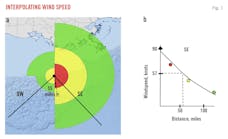Nick Snow
OGJ Washington Editor
WASHINGTON, DC, July 28 -- US Environmental Protection Agency statements on health benefits from lowering the ozone National Ambient Air Quality Standards grossly misrepresent what EPA actually estimates as possible benefits from reducing public ozone exposure, a new study commissioned by the American Petroleum Institute concluded.
“If based on ozone benefits alone, not one of EPA’s estimates of the benefits of reducing ozone to a tighter alternative ozone standard is as large as the costs of attaining that respective ozone standard,” the study by NERA Economic Consulting said. “All cost more than the ozone benefits they might provide.”
“The regulatory impact analysis is creating a misleading impression that the benefits would be reasonable,” said NERA Economic Consulting Senior Vice-Pres. Anne E. Smith, the study’s author, in a July 28 teleconference. “EPA’s own numbers show that the costs would be much greater than the benefits.” She was scheduled to meet with White House Office of Management and Budget officials later in the day.
“In fact, the ozone benefits would be small, and the costs of more stringent standards dwarf them,” said API Scientific and Regulatory Affairs Director Howard Feldman, who also participated. “No other rules could be more detrimental to economic growth, and they fly in the face of President Obama’s regulatory reform initiative.”
The study said EPA’s ozone benefits estimates from the proposed tighter standards does not consider that the agency has escalated those benefits by always including benefits due to ozone-related mortality. It said EPA’s independent scientific advisory committee found no causal link between ozone and mortality during its considerations, but the agency now presume that link as part of its reconsideration.
Despite this change that the scientific advisory committee does not support, “EPA’s net benefits estimates for ozone standards tighter than 0.75 ppm are all still deeply negative,” the study said.
Three main flaws
“In its analysis, EPA is unable to identify how the nation will comply with these new standards,” Feldman said. “EPA has proposed stringent new standards that are out-of-cycle, not supported by science, and would have devastating economic consequences. It should move forward with the normal 5-year review now under way.”
API has been working hard to change the administration’s mind, according to Khary Cauthen, the trade association’s government affairs director. “Our industry understands the value of air quality to our society, and has worked very hard over the years to reduce the emissions in the air we all breathe,” he said during the teleconference. “It is our hope that in the next month, the president will become involved and ask that this rule be pulled back and moved into the normal regulatory cycle.”
EPA does not even know how the new standards would be met, he continued. “Larger industries certainly would be more heavily impacted, but no business would remain untouched. The standards would be so close to background ozone levels that operations would close and business moved elsewhere,” Cauthen said. “This isn’t a recipe on how to rebuild an economy. All of this could affect the economic lives of millions of Americans. They need to know about the consequences and make their voices heard.”
Feldman conceded that EPA is not legally required to consider proposed regulations’ economic consequences, but added that they have to inform the agency administrator’s final decisions. “Past administrators have looked at how standards would be implemented, and have set them at attainable levels,” he said. “There’s no reason to move the goal posts now as we are trying to reach the present standard.”
API also announced that it is launching an advertising campaign to get citizens to telephone the White House and express concern about EPA’s proposed regulation. “You can’t work in a factory that was never built,” a print advertisement from the Coalition for American Jobs’ campaign says.
Contact Nick Snow at [email protected].

